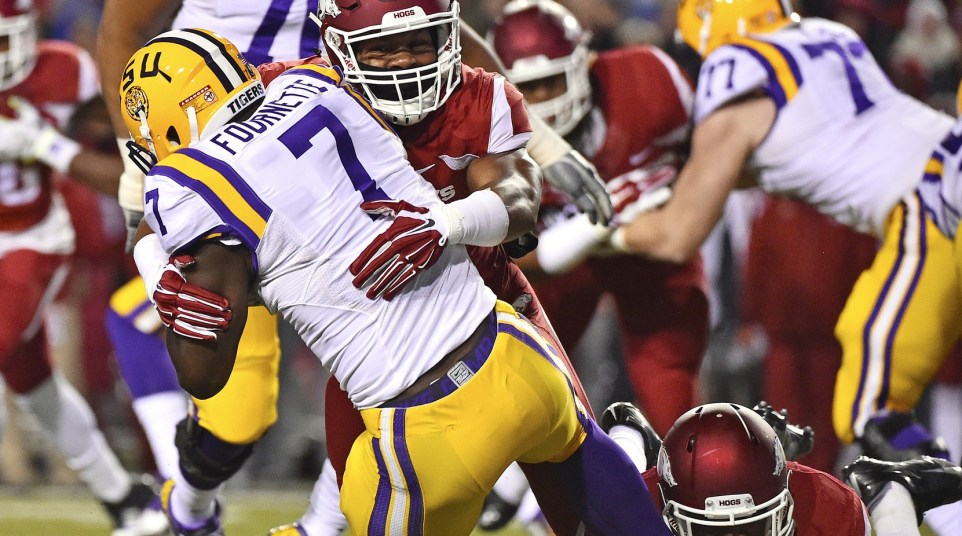LSU has to rebound on third down in 2015
If you’re looking for a telling sign of LSU’s regression last year, look no further than third down.
We’re not talking about the dreaded “third-and-Chavis,” when LSU’s defenses would give up a third- or fourth-and-long under their former defensive coordinator. We’re talking about the other side of the ball for the Tigers.
In 2013, LSU had the best third-down offense not just in the SEC, but in the entire nation at better than 57 percent. In 2014, the Tigers plummeted to 71st in the country and ninth in the SEC, dropping to 39.9 percent on third down, converting more than half of their third downs in just three games all year.
Of course, the reasons for the offense dropping off were right in front of our eyes. LSU lost several 2014 NFL contributors following the 2013 season: quarterback Zach Mettenberger, wide receivers Odell Beckham Jr. and Jarvis Landry and running backs Alfred Blue and Jeremy Hill. The final name there might have been the biggest loss; Hill averaged an insane 13.3 yards per carry on 18 third-down carries in 2013.
LSU replaced all those faces with mostly youth in 2014, although the Tigers did have two seniors in the backfield. Terrence Magee averaged 5.8 yards on 12 third-down carries, while Kenny Hilliard was limited to 3.6 yards per third-down tote.
Outside of those veterans, the rest of the team had major issues on third down.
Mostly led by quarterback Anthony Jennings, the Tigers floundered throwing the ball. LSU completed just 47.4 percent of its third-down passing attempts, somehow worse than the team’s paltry 50 percent overall completion rate. Of the 95 times LSU took to the air on third down, the Tigers converted just 31 of them, a rate of 32.6 percent.
The team was far better in terms of conversions on third down, turning 40 of their 83 rushing attempts into a new set of downs, but still averaged just under 3.0 yards per carry. It certainly didn’t help that Leonard Fournette, the Tigers’ star running back, was held to 1.6 yards per carry on third down.
Fournette’s improvement will be crucial in LSU upping it’s third-down success rates in 2015. The Tigers are retooling their offensive line, but will have two studs at the bookends in Vadal Alexander and Jerald Hawkins and an anchor in the middle in Ethan Pocic. It should be a unit they can count on to open up holes for Fournette. Last year, as a freshman, Fournette was at times impatient behind the line, plowing into his blockers instead of waiting for them to open up holes for him. That will likely be less of a problem as Fournette continues to develop.
If we can trust what the coaching staff says, the passing game should be improved as well. Both Jennings and Brandon Harris earned high praise from Cam Cameron and Les Miles during spring; Harris was in the coaches’ ears trying to glean as much playbook knowledge as possible, while Jennings was often labeled the better of the two in scrimmages. If the receiving corps improves as well — a reasonable thing to expect, considering that three of the four members of the rotation last year were freshmen — then LSU should be able to matriculate the ball through the air at least a bit more reliably.
Miles and Cameron are both counting on added experience to improve the Tigers’ success on third down. With youthful players all over the roster, LSU left some plays on the field due to lack of awareness, according to the coaches.
“I think sometimes guys lose track of not just the down, but they’ll lose track of the distance,” Cameron told ESPN.com.
“Recognizing where the sticks are is pretty elementary to me,” Miles added in the same story. “Geez, it’s third down. If you don’t know where you’re catching the ball and if you don’t know where the first-down marker is, we have some other things to teach.”
In the spring game, LSU converted 10-of-22 third downs, which stands as a major improvement from 2014. However, Cameron told ESPN that he thought his team could have avoided the two fourth-and-short attempts the team went for had they been a little more alert on the field.
Experience is one thing that can’t be taught. LSU certainly has talent, and after being forced to play more than 20 freshmen last year, along with a slew of other underclassmen, the team now has experience. LSU will have to hope that experience translates to greater success on third down, and by extension the offense as a whole.

